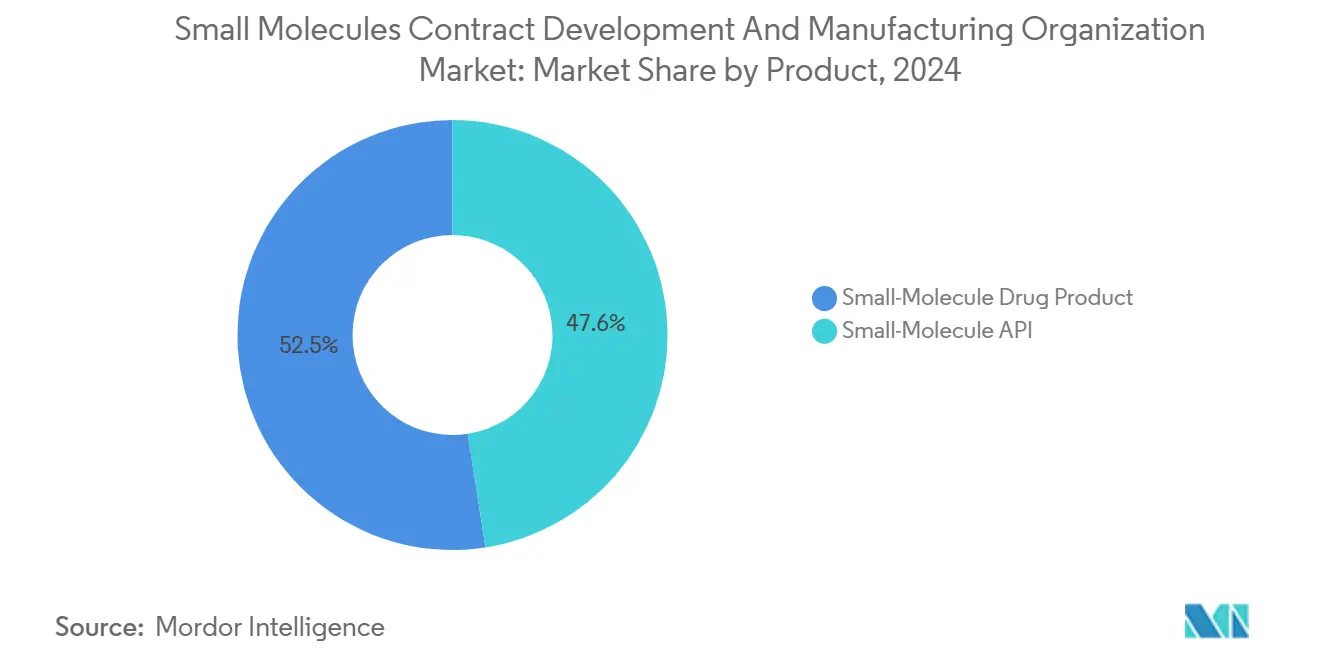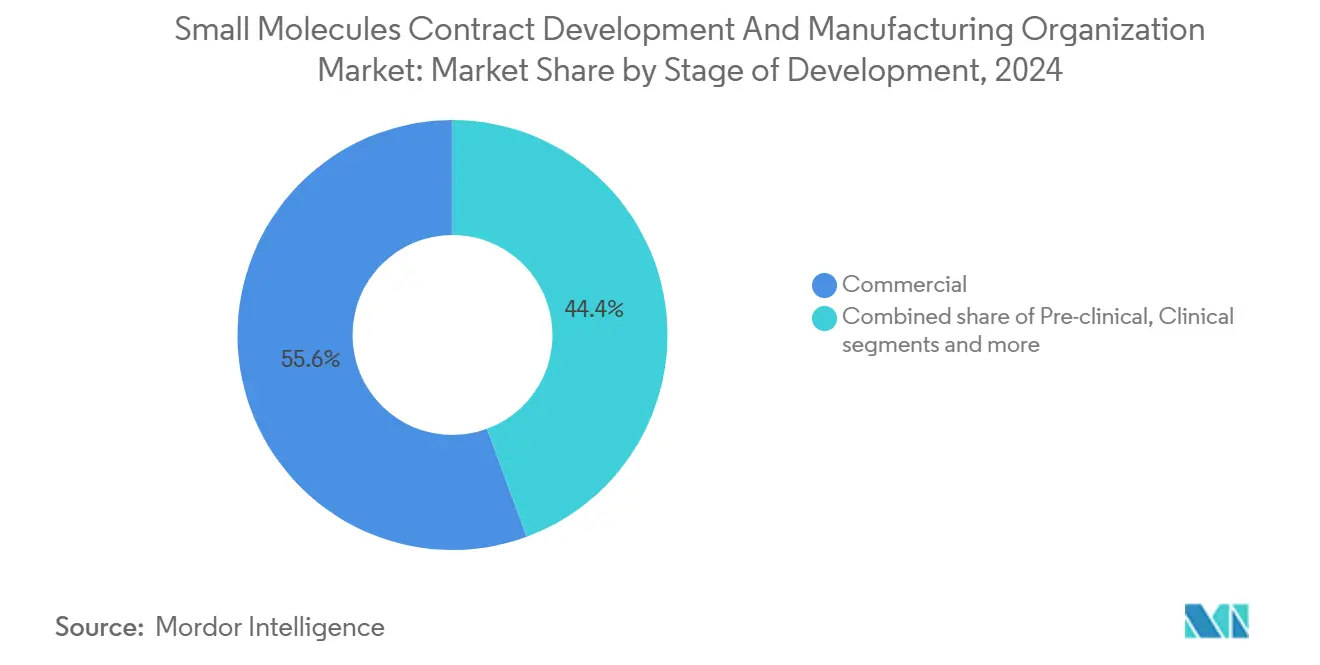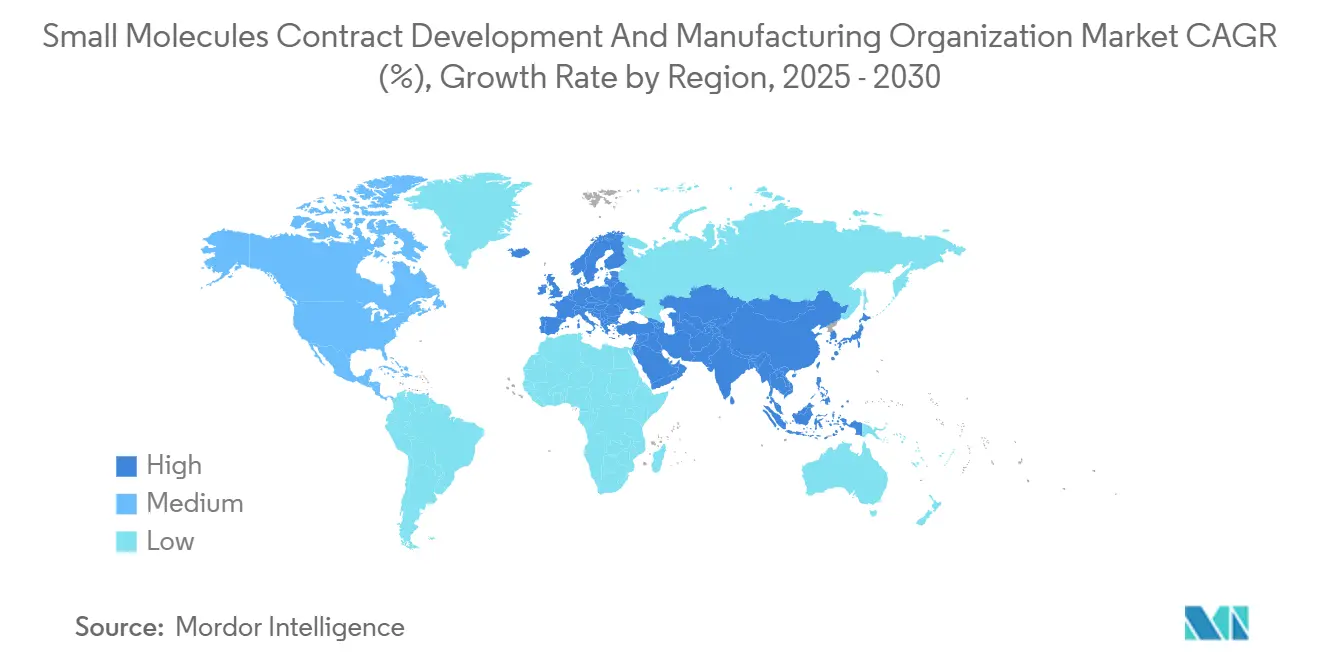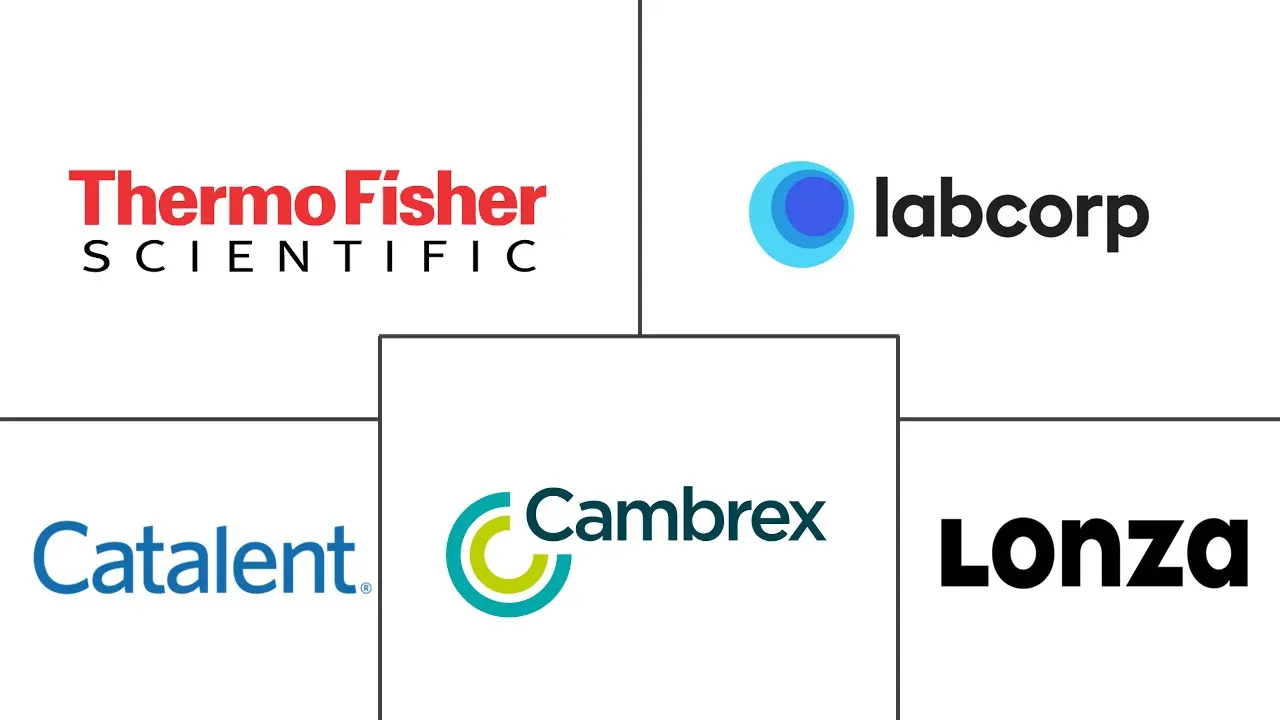Small Molecules Contract Development And Manufacturing Organization Market Size and Share

Small Molecules Contract Development And Manufacturing Organization Market Analysis by Mordor Intelligence
The Small Molecules Contract Development And Manufacturing Organization Market size is estimated at USD 193.64 billion in 2025, and is expected to reach USD 275.04 billion by 2030, at a CAGR of 7.27% during the forecast period (2025-2030).
This acceleration reflects pharmaceutical innovators’ strategic pivot toward asset-light models, where outsourcing complex API synthesis and drug-product manufacturing frees capital for higher-value R&D. Continuous manufacturing, artificial-intelligence–driven process optimization, and heightened regulatory focus on supply-chain resilience amplify demand for best-in-class CDMOs. The Novo Holdings acquisition of Catalent for USD 16.5 billion in December 2024 underscores the market’s status as critical infrastructure for next-generation therapeutics. Scale advantages coexist with specialization pressures: small-molecule drug-product services command more than half of current revenues, yet early-stage pipeline support and integrated CMC solutions register the fastest growth. Regionally, North America leads on revenue, whereas Asia-Pacific delivers the highest growth trajectory, supported by cost-advantaged capacity additions and government incentives that attract multinational programs.
Key Report Takeaways
- By product category, small-molecule drug-product manufacturing held 52.45% revenue share of the small molecules contract development and manufacturing organization market in 2024; small-molecule drug-product services are forecast to expand at a 7.60% CAGR through 2030.
- By service type, drug-product formulation and manufacturing recorded the fastest 7.70% CAGR, while drug-substance services retained 48.90% of the small molecules contract development and manufacturing organization market share in 2024.
- By stage of development, commercial-stage projects accounted for 55.61% share in 2024, whereas pre-clinical services are projected to grow at 7.80% CAGR to 2030.
- By therapeutic area, oncology dominated with 53.82% share of the small molecules contract development and manufacturing organization market size in 2024 and is advancing at a 7.91% CAGR through 2030.
- By geography, North America contributed 42.23% revenue in 2024, while Asia-Pacific is forecast to register the highest 8.01% CAGR over 2025-2030.
Global Small Molecules Contract Development And Manufacturing Organization Market Trends and Insights
Driver Impact Analysis
| Driver | (~) % Impact on CAGR Forecast | Geographic Relevance | Impact Timeline |
|---|---|---|---|
| Rising outsourcing of API & FDF manufacturing by Big Pharma | +1.8% | Global, with concentration in North America & Europe | Medium term (2-4 years) |
| Surge in small-molecule oncology approvals post-2025 | +1.2% | North America & EU regulatory markets, manufacturing globally | Long term (≥ 4 years) |
| Cost-advantaged capacity expansions in APAC CDMO clusters | +1.4% | APAC core, with spillover benefits to global supply chains | Medium term (2-4 years) |
| AI-driven process-optimization platforms reducing CMC timelines | +1.1% | North America & EU early adopters, expanding to APAC | Long term (≥ 4 years) |
| HPAPI demand for targeted therapeutics (under-supplied sub-scale) | +0.9% | Global, with specialized facilities concentrated in North America & Europe | Long term (≥ 4 years) |
| Source: Mordor Intelligence | |||
Rising Outsourcing of API & FDF Manufacturing by Big Pharma
Manufacturing is no longer regarded as a strategic asset inside many large pharmaceutical firms; instead, executives channel capital into discovery platforms and late-stage clinical programs. The Cambrex-Eli Lilly dedicated-capacity agreement concluded in December 2024 illustrates how Big Pharma now secures external capacity rather than erecting additional internal plants. Once transfer of know-how is complete, sponsors rarely reverse such outsourcing moves, creating a structural, rather than cyclical, pull on the small molecules contract development and manufacturing organization market. CDMOs with long regulatory track records, multiproduct containment suites, and robust quality systems capture premium pricing because sponsors prize reliability over marginal cost savings. Outsourcing momentum is reinforced by internal head-count constraints following multiple waves of pharma restructuring that depleted in-house manufacturing expertise. This sustained flow of contracts helps de-risk capital-intensive CDMO expansions and fuels consolidation, as scale becomes necessary to service pipeline breadth and global launches without supply interruptions.
Surge in Small-Molecule Oncology Approvals Post-2025
The oncology pipeline produced 91% of the FDA’s 50 novel small-molecule approvals in 2024, and the momentum is expected to continue as precision-medicine research matures. High-potency APIs require stringent containment, specialized personal protective equipment, and validated cleaning protocols, capabilities that only a subset of CDMOs have mastered. Olon’s EUR 25 million ultra-potent facility activated in January 2025 exemplifies the escalating infrastructure investments needed to compete in this segment. Oncology sponsors value CDMOs that integrate route scouting, high-potency API production, and late-stage drug-product formulation under one quality system, shortening tech-transfer timelines. Updated nitrosamine guidance issued in September 2024 increases analytical complexity, incentivizing innovators to partner with providers possessing in-house genotoxic-impurity expertise. This demand pattern lifts project backlogs and utilization rates, reinforcing price discipline and strengthening revenue visibility for specialized providers.
Cost-Advantaged Capacity Expansions in APAC CDMO Clusters
Asia-Pacific governments offer tax holidays, expedited permitting, and workforce subsidies that have spurred a new wave of small-molecule GMP capacity. SK Pharmteco broke ground on a USD 260 million, 190,000-square-foot facility in Sejong, South Korea in early 2025, targeting late-phase and commercial APIs. Navin Molecular invested USD 35 million in Dewas, India to expand kilogram-scale cytotoxic capabilities, while Cohance Lifesciences allocated INR 230 million to an oligonucleotide unit in Hyderabad, all scheduled to come online before 2027. Cluster effects emerge as multiple CDMOs locate near each other, creating shared raw-material networks and talent pools that lower delivered-cost structures by 30-40% compared with Western plants. The resulting economics allow APAC providers to secure multi-year contracts at attractive margins without undercutting global price floors. Integrated quality-management upgrades and dual-sourcing strategies adopted by Western sponsors further legitimize these facilities, funneling a rising share of early-phase work to the region without compromising regulatory compliance standards.
AI-Driven Process-Optimization Platforms Reducing CMC Timelines
Artificial intelligence is moving from buzzword to differentiator as CDMOs deploy machine-learning models that predict reaction-parameter windows, detect out-of-spec trends, and recommend batch-release decisions. The FDA’s Advanced Manufacturing Technologies Designation Program, finalized in January 2025, guarantees review-time advantages for applicants incorporating digital twins and continuous-manufacturing lines. Early adopters report 40-60% compression in process-development timelines, enabling sponsors to shave six to nine months off IND-to-NDA pathways. Yield improvement and scrap reduction further magnify economic benefits, ensuring rapid payback for AI investments. Proprietary datasets generated during model training turn into defensible intellectual property, creating switching costs that tether clients to technology-enabled CDMOs. Vendors lacking data-science depth face widening capability gaps, driving merger activity aimed at acquiring proven digital platforms rather than mere capacity.
Restraint Impact Analysis
| Restraint | (~) % Impact on CAGR Forecast | Geographic Relevance | Impact Timeline |
|---|---|---|---|
| US–EU export-control tightening on dual-use synthesis equipment | -0.9% | Global, with primary impact on US-EU to APAC technology transfers | Short term (≤ 2 years) |
| Global shortage of senior QC chemists inflating labour costs | -0.7% | Global, with acute impacts in North America and Western Europe | Medium term (2-4 years) |
| Rising ESG-linked financing premiums for solvent-intensive CDMOs | -0.6% | Global, with particular impact on European and North American markets | Medium term (2-4 years) |
| Source: Mordor Intelligence | |||
US–EU Export-Control Tightening on Dual-Use Synthesis Equipment
Amendments to the U.S. Export Administration Regulations effective December 2024 restrict shipments of automated peptide synthesizers, continuous-flow reactors, and advanced containment skids to regions flagged for potential diversion. Parallel measures under the Australia Group extend license requirements to European suppliers. APAC startups now encounter protracted lead times or outright denials when sourcing critical equipment, freezing expansion plans and lengthening validation cycles. Western CDMOs benefit in the near term because sponsors gravitate toward proven suppliers that already possess restricted assets, but domestic operators also shoulder higher capital-replacement costs due to limited vendor pools. In the small molecules contract development and manufacturing organization market, the policy shifts create geographically uneven capacity additions, ultimately pressuring global supply resilience if bottlenecks persist beyond the initial compliance horizon.
Global Shortage of Senior QC Chemists Inflating Labor Costs
Regulatory submissions cite analytical method validation and ongoing batch release as the top contributors to inspection observations, underscoring the premium on experienced quality-control professionals. Industry surveys show eight of ten facilities reporting open senior-chemist requisitions lasting more than six months. Wage inflation reached 15-25% annually in North America and Europe during 2024-2025, prompting some midsize CDMOs to delay expansion projects or shift workloads to automated platforms. Automation mitigates head-count strain but demands upfront investment and specialized maintenance skills that are also in short supply. Smaller providers unable to match compensation offered by industry majors experience rising turnover, eroding compliance robustness and elongating client-audit closeouts. Over the medium term, analytical-lab digitization and remote-review technologies may relieve pressure, yet structural demographic gaps indicate that labor costs will remain a drag on the small molecules contract development and manufacturing organization market CAGR.
Segment Analysis
By Product: Drug Products Drive Manufacturing Complexity
Small-molecule drug-product services captured 52.45% of the small molecules contract development and manufacturing organization market in 2024, reflecting sponsor demand for single-source partners that manage formulation, filling, and secondary packaging under a unified quality system. The segment is forecast to post a 7.60% CAGR to 2030, outpacing API-only work as innovators increasingly bundle substance and product needs within long-term master service agreements. Oral-solid-dose projects dominate by volume thanks to patient familiarity and cost-efficient scaling, yet high-value growth resides in sterile injectables, fast-dissolving films, and abuse-deterrent tablets that require specialized equipment and containment expertise. Advanced polysorbate-free formulations for biologic-like small molecules and nanocrystal suspensions further complicate manufacturing, creating entry barriers that protect incumbents.
Demand patterns translate into capacity expansions such as the January 2025 BioCina-NovaCina merger that combines microbial expression systems with sterile fill-finish suites. Sponsors cite reduced tech-transfer risk and simplified regulatory oversight as primary reasons for awarding integrated drug-product mandates. In turn, CDMOs leverage these contracts to secure forward capacity commitments, supporting capex programs that embed new isolator technology and multiproduct lyophilization lines. The resulting ecosystem reinforces integrated providers’ share of the small molecules contract development and manufacturing organization market size while encouraging API specialists to acquire downstream capabilities or risk relegation to price-centric procurement pools.

By Service Type: Integration Drives Premium Positioning
Drug-substance development and manufacturing retained 48.90% of 2024 revenues, yet drug-product formulation and manufacturing posted the fastest 7.70% growth, evidencing sponsor preference for turnkey chemistry, manufacturing, and controls solutions. Analytical and regulatory services, though smaller in revenue, deliver high margins and client lock-in, especially as global nitrosamine and elemental-impurity guidelines add complexity. EUROAPI’s January 2025 collaboration with SpiroChem exemplifies the pivot toward CRO-CDMO convergence, offering route-scouting to GMP material under one contract.
Packaging and serialization, historically viewed as commoditized, now occupy strategic footing because track-and-trace mandates in the United States, European Union, and emerging markets require serialized packaging lines capable of aggregating data across multiple packaging hierarchies. CDMOs that invested early in Level-4/Level-5 IT connectivity capture incremental revenue and shield clients from DSCSA-related penalties. Over the forecast horizon, service-portfolio breadth, not isolated cost efficiency, will dictate share gains in the small molecules contract development and manufacturing organization market.
By Stage of Development: Commercial Dominance Meets Pre-Clinical Growth
Commercial projects contributed 55.61% of 2024 revenue, underpinning predictable cash flows that finance greenfield expansions and continuous-manufacturing retrofits. Sponsors favor CDMOs offering late-stage process validation, lifecycle management, and global regulatory filing support. However, pre-clinical services are slated for a 7.80% CAGR through 2030, propelled by venture-capital inflows into early-stage biotechs and the sheer breadth of novel targets enabled by AI-mediated drug discovery. The Lyndra-Thermo Fisher partnership announced May 2025 captures this dynamic, pairing specialized oral-delivery technology with end-to-end CDMO capabilities to de-risk scale-up for complex, long-acting formulations.
Phase I-III projects remain sensitive to timeline slippages; consequently, CDMOs with dedicated, multi-client suites and rapid-changeover equipment absorb a disproportionate share of early-stage awards. Process-knowledge digitalization at each development gateway compounds into shorter validation cycles once products reach commercialization, reinforcing incumbents’ lifecycle revenue streams and contributing to the estimated USD 71.02 billion small molecules contract development and manufacturing organization market size by 2030.

Note: Segment shares of all individual segments available upon report purchase
By Therapeutic Area: Oncology Leadership Drives Specialization
Oncology applications represented 53.82% of 2024 value and are advancing at a 7.91% CAGR, cementing their role as the lead demand engine within the small molecules contract development and manufacturing organization market. High-potency containment and lyophilized-injectable dosage forms dominate capital requests, while accompanying analytical requirements—such as ultra-low residual-solvent quantitation—favor CDMOs holding specialized instrumentation. Cardiovascular and infectious-disease programs, though lower-growth, provide volume ballast that stabilizes utilization rates across reactor networks.
Neurology and metabolic disorders offer nascent growth as GLP-1 receptor agonists and blood-brain-barrier-penetrating molecules move through pipelines, demanding chiral-resolution expertise and complex stabilizers. Respiratory products benefit from rising prevalence of chronic obstructive pulmonary disease in aging populations, spurring demand for multi-dose dry-powder inhaler filling lines. As therapeutic portfolios diversify, CDMOs that combine dedicated oncology suites with flexible non-potent capacity maximize client capture across multiple indications, underpinning their expanding share of the Ssmall molecules contract development and manufacturing organization market.
Geography Analysis
North America accounted for 42.23% revenue in 2024 thanks to FDA familiarity, near-patient logistics, and government incentives favoring domestic production. The BIOSECURE Act debate intensifies momentum for reshoring critical-medicine manufacturing, leading to facility investments like Croda’s USD 23,680-square-foot lipid site in Pennsylvania, inaugurated March 2025[1]Source: Croda International, “Advanced Lipids Facility Opens in Pennsylvania,” croda.com . Multistate incentive packages further reduce effective tax rates for capital-intensive expansions, making the region attractive despite higher labor costs.
Asia-Pacific is projected to register the highest 8.01% CAGR, anchored by cost-advantaged clusters in South Korea, India, and Singapore. Regulatory agencies such as South Korea’s MFDS now offer priority-review lanes for continuous-manufacturing lines, aligning local CDMO capabilities with ICH expectations. Currency-adjusted labor-rate differentials, combined with vertically integrated chemical supply chains, enhance cost competitiveness without compromising compliance. Multinational sponsors manage perceived geopolitical risk through dual-site strategies, allocating early-phase or non-potent demand to APAC while reserving high-potency or launch-critical volumes for Western sites, balancing cost and security across their portfolios.
Europe commands a mature but innovation-focused share, buoyed by EMA harmonization, stringent environmental rules, and energy-efficiency grants that favor continuous-manufacturing retrofits. Switzerland’s Dottikon ES announced CHF 700 million in small-molecule capacity additions in September 2024, reflecting regulatory stability and local talent depth. Sustainability targets embedded in the European Green Deal elevate demand for solvent-recovery systems and biomass-based feedstocks, creating new service niches for CDMOs capable of delivering low-carbon footprints alongside cGMP compliance. Collectively, geographic diversification strategies pursued by sponsors fuel a resilient, multidirectional growth path for the small molecules contract development and manufacturing organization market.

Competitive Landscape
Market structure combines moderate concentration at the top with a competitive fringe of specialists. Lonza, Catalent, Thermo Fisher Scientific, and WuXi AppTec leverage global footprints, multiproduct campuses, and integrated offerings to secure multi-asset master agreements. Novo Holdings’ takeover of Catalent and associated USD 11 billion divestiture of three fill-finish sites to Novo Nordisk highlight the strategic premium assigned to secured capacity for GLP-1 and obesity franchises[2]Source: Novo Holdings, “Novo Holdings Completes Catalent Acquisition,” novoholdings.dk . Scale economies enable these leaders to spread quality-system overhead across diverse projects, reinforcing margins even as pricing pressure emerges in commoditized chemistries.
Below the top tier, regional champions such as Cambrex, Dottikon ES, and SK Pharmteco differentiate through technology depth—high-potency APIs, continuous-flow reactors, or oligonucleotide platforms—commanding premium pricing in their niches. AI-native CDMOs, often venture-backed, are beginning to capture discovery-stage contracts by offering predictive process-development timelines unattainable under empirical paradigms. Export-control tightening shapes competitive asymmetries by limiting technology diffusion, granting incumbents quasi-regulatory moats. Simultaneously, labor scarcity accelerates automation adoption, favoring capital-rich operators that can absorb upfront costs.
Consolidation is expected to continue as investors seek scale synergies, geographic risk hedging, and broader service portfolios. However, the coexistence of high-growth micro-niches—peptides, antibody-drug conjugates, and ultra-potent oncology APIs—ensures a steady pipeline of specialized entrants. Overall, the dynamic interplay of scale and specialization propels the competitive intensity that defines the small molecules contract development and manufacturing organization market today.
Small Molecules Contract Development And Manufacturing Organization Industry Leaders
-
Catalent Inc
-
Lonza
-
Thermo Fisher Scientific, Inc
-
Labcorp Drug Development
-
Cambrex Corporation
- *Disclaimer: Major Players sorted in no particular order

Recent Industry Developments
- March 2025: Croda opened a USD 23,680-square-foot lipid manufacturing plant in Lamar, Pennsylvania to bolster supply security for advanced drug-delivery systems.
- January 2025: BioCina and NovaCina merged to create a combined biopharmaceutical and small-molecule CDMO operating FDA- and EMA-approved facilities in Australia
Global Small Molecules Contract Development And Manufacturing Organization Market Report Scope
As per the scope of the report, a contract development and manufacturing organization (CDMO) is an organization that provides clients with comprehensive services from drug development through manufacture. In the small molecule manufacturing sector, CDMOs provide expert development and manufacturing services and are now an essential part of the pharmaceutical industry's value chain.
The small molecule contract development and manufacturing organization market is segmented by product (small molecule API, small molecule drug product (oral solid dose, semi-solid dose, liquid dose, and other small molecule drug products), stage type (preclinical, clinical (phase I, phase II, phase III, and phase IV), and commercial), end user (pharmaceutical and biotechnology companies, research institutes and academics), therapeutic area (cardiovascular diseases, oncology, respiratory disorders, neurology, metabolic disorders, infectious diseases, and other therapeutic areas), and geography (North America, Europe, Asia-Pacific, Middle East and Africa, and South America). The report also covers the estimated market sizes and trends for 17 countries across major regions globally. The report offers the market size in value terms in USD for all the abovementioned segments.
| Small-Molecule API | |
| Small-Molecule Drug Product | Oral Solid Dose |
| Semi-Solid Dose | |
| Liquid Dose | |
| Others |
| Drug-Substance (API) Development & Manufacturing |
| Drug-Product Formulation & Manufacturing |
| Analytical & Regulatory Services |
| Packaging & Serialization |
| Pre-clinical | |
| Clinical | Phase I |
| Phase II | |
| Phase III | |
| Phase IV | |
| Commercial | |
| Oncology |
| Cardiovascular |
| Infectious Diseases |
| Neurology |
| Respiratory Disorders |
| Metabolic & Endocrine |
| Others |
| North America | United States |
| Canada | |
| Mexico | |
| Europe | Germany |
| United Kingdom | |
| France | |
| Italy | |
| Spain | |
| Rest of Europe | |
| Asia-Pacific | China |
| India | |
| Japan | |
| South Korea | |
| Australia | |
| Rest of Asia-Pacific | |
| South America | Brazil |
| Argentina | |
| Rest of South America | |
| Middle East and Africa | GCC |
| South Africa |
| By Product | Small-Molecule API | |
| Small-Molecule Drug Product | Oral Solid Dose | |
| Semi-Solid Dose | ||
| Liquid Dose | ||
| Others | ||
| By Service Type | Drug-Substance (API) Development & Manufacturing | |
| Drug-Product Formulation & Manufacturing | ||
| Analytical & Regulatory Services | ||
| Packaging & Serialization | ||
| By Stage of Development | Pre-clinical | |
| Clinical | Phase I | |
| Phase II | ||
| Phase III | ||
| Phase IV | ||
| Commercial | ||
| Oncology | ||
| By Therapeutic Area | Cardiovascular | |
| Infectious Diseases | ||
| Neurology | ||
| Respiratory Disorders | ||
| Metabolic & Endocrine | ||
| Others | ||
| By Geography | North America | United States |
| Canada | ||
| Mexico | ||
| Europe | Germany | |
| United Kingdom | ||
| France | ||
| Italy | ||
| Spain | ||
| Rest of Europe | ||
| Asia-Pacific | China | |
| India | ||
| Japan | ||
| South Korea | ||
| Australia | ||
| Rest of Asia-Pacific | ||
| South America | Brazil | |
| Argentina | ||
| Rest of South America | ||
| Middle East and Africa | GCC | |
| South Africa | ||
Key Questions Answered in the Report
How large is the Small Molecules Innovator Contract Development And Manufacturing Organization market today?
The market generated USD 193.64 billion in 2025 and is projected to reach USD 257.04 billion by 2030, reflecting a 7.27% CAGR.
Which product segment contributes the most revenue?
Drug-product manufacturing leads with a 52.45% share in 2024, supported by growing demand for integrated formulation and packaging services.
Which region is expanding the fastest?
Asia-Pacific is forecast to deliver the highest 8.01% CAGR through 2030, driven by cost-advantaged capacity additions and supportive government policies.
Why are oncology programs critical for CDMOs?
Oncology commands 53.82% of current demand and requires high-potency containment and complex analytical capabilities that most innovators outsource to specialized CDMOs.
How are technology trends such as AI influencing CDMOs?
AI-enabled process-optimization platforms reduce CMC timelines by up to 60%, lower material scrap, and create proprietary data assets that differentiate leading providers.
What recent deal signals growing consolidation?
Novo Holdings USD 16.5 billion acquisition of Catalent in December 2024 illustrates how investors value large-scale, technologically advanced CDMO platforms.
Page last updated on:



